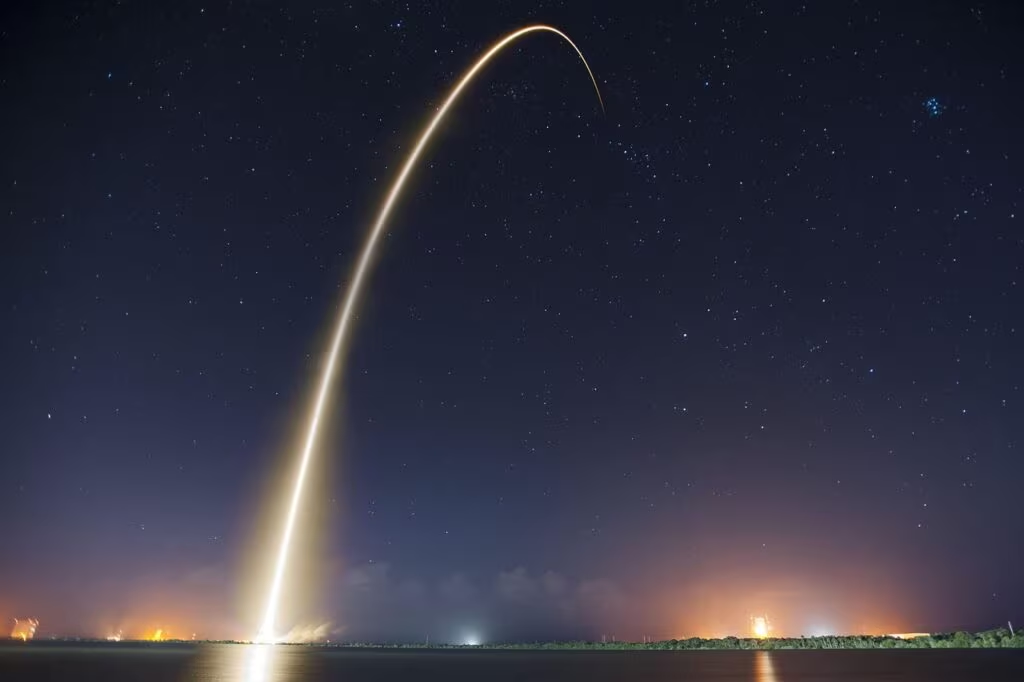SpaceX Completes Starlink 6-79 Mission, Setting New Annual Record
SpaceX has achieved a staggering operational milestone, successfully completing its 150th Falcon 9 mission of the year. This unprecedented launch cadence underscores the maturity and reliability of the company’s reusable rocket technology, further solidifying its dominance in the global launch market.
The mission, designated Starlink 6-79, successfully deployed 29 more Starlink satellites into Low Earth Orbit (LEO), continuing the rapid expansion of the company’s global broadband internet constellation. The launch occurred from Space Launch Complex 40 (SLC-40) at Cape Canaveral Space Force Station (CCSFS) in Florida.

The Reusable Workhorse: Booster B1090 Completes 14th Flight
The success of SpaceX’s high-tempo operations rests entirely on the rapid reusability of its Falcon 9 first-stage boosters. The booster supporting this specific mission, designated B1090, demonstrated exceptional durability by completing its 14th successful flight.
This booster has become a veteran of the fleet, having previously supported a diverse array of missions, including several other Starlink deployments and crucial rideshare missions. The ability to turn around a single booster 14 times within a few years is a feat unmatched in the history of rocketry, drastically reducing the cost and time associated with space access.
Following stage separation, the B1090 booster executed a flawless atmospheric re-entry burn and landing maneuver. It touched down safely on the autonomous droneship, aptly named A Shortfall of Gravitas (ASOG), stationed several hundred miles downrange in the Atlantic Ocean.
The Importance of Droneship Recovery
The recovery of the first stage on droneships like ASOG is essential for missions that require the rocket to carry a heavier payload or achieve a higher velocity, leaving insufficient fuel reserves to return to a land-based landing zone. The precision required for these offshore recoveries highlights the sophisticated guidance and navigation systems developed by SpaceX.
“The 150th mission milestone is not just a number; it represents a fundamental shift in how we approach space access. Reusability is no longer theoretical—it is the backbone of our operational model,” a company spokesperson noted following the launch.

Starlink’s Expanding Footprint
The 29 satellites deployed during the Starlink 6-79 mission contribute to the growing constellation designed to provide high-speed, low-latency internet access globally. Starlink operates in Low Earth Orbit (LEO), which is significantly closer to Earth than traditional geostationary satellites, resulting in much faster response times (latency) crucial for modern internet applications.
Contextualizing the Constellation
As of early 2025, SpaceX continues to launch satellites at an aggressive pace to meet global demand and maintain coverage. The Starlink network is designed to be resilient and scalable, requiring thousands of operational satellites to ensure continuous, worldwide coverage. Each launch, like Starlink 6-79, incrementally improves the network’s capacity and reliability, especially in remote or underserved areas.
Key Starlink Facts:
- Purpose: Global broadband internet access.
- Orbit: Low Earth Orbit (LEO), typically between 350 km and 550 km.
- Benefit: Significantly lower latency compared to traditional satellite internet.
- Operational Goal: To provide service to millions of users across all continents.
The Significance of 150 Launches in a Year
Achieving 150 orbital launches in a single year is a landmark achievement that demonstrates an industrial-scale capability in spaceflight. To put this operational tempo into perspective, for many decades, the United States and Russia combined rarely exceeded 50 orbital launches annually. SpaceX’s current pace means they are launching, on average, a Falcon 9 rocket every 2.4 days.
This high frequency is critical for several reasons:
- Constellation Deployment: It allows for the rapid deployment and replenishment of the massive Starlink network, maintaining competitive advantage.
- Commercial Reliability: It offers unprecedented reliability and scheduling flexibility for third-party commercial and government clients.
- Cost Reduction: The sheer volume of launches drives down the marginal cost per launch, making space access more affordable for everyone.

Key Takeaways
The Starlink 6-79 mission was a standard deployment that carried extraordinary significance due to the milestone it represented. The key points for readers are:
- Record Cadence: SpaceX successfully completed its 150th Falcon 9 mission of the year, cementing its position as the world’s most frequent launch provider.
- Mission Specifics: The Starlink 6-79 mission deployed 29 satellites from SLC-40 at CCSFS.
- Booster Reusability: The B1090 booster completed its 14th flight, landing successfully on the droneship A Shortfall of Gravitas.
- Network Expansion: The new satellites contribute to the rapid expansion of the Starlink LEO broadband constellation.
What’s Next
SpaceX shows no signs of slowing its operational tempo. The company is expected to continue prioritizing Starlink deployments while also preparing for the next generation of super-heavy lift vehicles, such as Starship. The lessons learned and the operational efficiency gained from the 150 Falcon 9 missions will be directly applied to scaling up future launch systems. Readers can anticipate continued weekly—and sometimes daily—launch activity from both the Florida and California launch sites as the company pushes toward even higher annual launch totals in the coming years.
Original author: Robert Z. Pearlman
Originally published: November 22, 2025
Editorial note: Our team reviewed and enhanced this coverage with AI-assisted tools and human editing to add helpful context while preserving verified facts and quotations from the original source.
We encourage you to consult the publisher above for the complete report and to reach out if you spot inaccuracies or compliance concerns.

